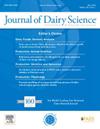A randomized controlled trial evaluating the effect of providing a rest period during long-distance transportation of surplus dairy calves: Part II. Effect on hematological variables
IF 3.7
1区 农林科学
Q1 AGRICULTURE, DAIRY & ANIMAL SCIENCE
引用次数: 0
Abstract
The objective of this randomized controlled trial was to determine if providing a rest stop including provision of feed and water between periods of continuous transportation mitigates the effect of long-distance transportation on markers of energy status and hydration in calves transported by road for 16 h. This study was conducted between September 2022 to January 2023 and included male and female Holstein and crossbred dairy calves ≥7 d old from 2 commercial dairy farms in Ontario, Canada (n = 96). On the day before transportation, calves were enrolled and randomly assigned to one of 2 treatment groups: (1) continuous transportation by road for 16 h or (2) 8 h of transport, 8 h of rest, and a further 8 h of transport to a single calf-raising facility. Calves that received a rest stop were fed 2 L of milk replacer at the time of unloading for the rest period and again immediately before reloading for the second leg of the journey. Blood samples were collected before and after transportation as well as daily for 3 d following arrival to the calf-raising facility. Serum was analyzed for concentrations of BHB, nonesterified fatty acids (NEFA), haptoglobin, and creatine kinase, and acid-base disturbances were evaluated within 1 h of collection of whole blood to assess glucose, sodium, potassium, ionized calcium, hematocrit, hemoglobin, pH, base excess, partial pressure of oxygen, total carbon dioxide, bicarbonate, partial pressure of carbon dioxide, and oxygen saturation. Mixed linear regression models with repeated measures were built to assess the effect of treatment group, age at transportation, breed, and sex on these parameters. Immediately after transportation, calves that received the rest period had lower BHB (−68.04 μmol/L, 95% CI: −99.59 to −36.49), NEFA (−0.14 mmol/L, 95% CI −0.22 to −0.07), and sodium (−1.10 mmol/L, 95% CI = −2.18 to −0.02), and higher glucose (0.48 mmol/L, 95% CI = 0.21 to 0.74), potassium (0.27 mmol/L, 95% CI = 0.11 to 0.43), ionized calcium (0.06 mmol/L, 95% CI = 0.03 to 0.08), and oxygen saturation (8.76%, 95% CI = 1.61 to 15.91) compared with calves that were continuously transported for 16 h. Additionally, calves transported between 11 and 12 d old had lower hematocrit (−1.22%, 95% CI = −2.19 to −0.25), hemoglobin (−3.07 g/L, 95% CI = −5.70 to −0.43), haptoglobin (−0.13 g/L, 95% CI = −0.23 to −0.02), and potassium (−0.13 mmol/L, 95% CI = −0.22 to −0.04) and higher sodium (0.83 mmol/L, 95% CI = 0.03 to 1.63) than 7 to 8 d old calves. Furthermore, calves that were 13 to 24 d old at transport had lower haptoglobin (−0.16 g/L, 95% CI = −0.27 to −0.06) and potassium (−0.14 mmol/L, 95% CI = −0.23 to −0.05), and higher sodium (1.02 mmol/L, 95% CI = 0.22 to 1.82) and ionized calcium (0.02 mmol/L, 95% CI = 0.002 to 0.035) compared with calves transported at 7 to 8 d old. The results of this trial demonstrate that a rest period improves energy status upon arrival to a calf-raising facility, suggesting that the benefit of a rest period may be mostly related to the provision of mid-journey milk meals.
一项随机对照试验,评估在长途运输剩余奶牛期间提供休息时间的效果:第二部分。对血液变量的影响。
本随机对照试验的目的是确定在连续运输期间提供休息站(包括提供饲料和水)是否能减轻长途运输对陆路运输 16 小时的犊牛能量状态和水合作用指标的影响。本研究在 2022 年 9 月至 2023 年 1 月期间进行,包括来自加拿大安大略省 2 个商业奶牛场的≥7 d 大的荷斯坦和杂交雌雄乳牛(n = 96)。在运输前一天,犊牛被登记并随机分配到两个处理组中的一个:1)连续公路运输 16 小时;或 2)运输 8 小时,休息 8 小时,然后再运输 8 小时到一个犊牛饲养场。休息时间的犊牛在卸货休息时喂食 2 升代乳粉,并在第二段行程重新装车前再次喂食代乳粉。在运输前后以及到达犊牛饲养场后的 3 天内,每天采集血液样本。对血清中的β-羟丁酸(BHBA)、非酯化脂肪酸(NEFA)、血红蛋白和肌酸激酶浓度进行分析,同时在采集全血后 1 小时内对酸碱紊乱进行评估,以评估葡萄糖、钠、钾、离子钙、血细胞比容、血红蛋白、pH 值、碱过量、pO2、TCO2、HCO3、pCO2 和 sO2。建立了重复测量的混合线性回归模型,以评估处理组、运输年龄、品种和性别对这些参数的影响。运输后,接受休息期的犊牛的 BHBA(-68.04 μmol/L,95% CI:-99.59 至 -36.49)、NEFA(-0.14 mmol/L,95% CI -0.22 至 -0.07)和钠(-1.10 mmol/L,95% CI = -2.18至-0.02),葡萄糖(0.48毫摩尔/升,95% CI = 0.21至0.74)、钾(0.27毫摩尔/升,95% CI = 0.11至0.43)、离子钙(0.06毫摩尔/升,95% CI = 0.03至0.08)和sO2(8.76%,95% CI = 1.61至15.91)较高。此外,与连续运输 16 h 的犊牛相比,运输时间在 11 至 12 d 之间的犊牛的血细胞比容(-1.22%,95% CI = -2.19 至 -0.25)、血红蛋白(-3.07 g/L,95% CI = -5.70 to -0.43)、血红蛋白(-0.13 g/L,95% CI = -0.23 to -0.02)和钾(-0.13 mmol/L,95% CI = -0.22 to -0.04),而钠(0.83 mmol/L,95% CI = 0.03 to 1.63)则高于7-8 d大的犊牛。此外,与7-8日龄的犊牛相比,运输时13-24日龄的犊牛血红蛋白(-0.16 g/L,95% CI = -0.27 to -0.06)和钾(-0.14 mmol/L,95% CI = -0.23 to -0.05)较低,钠(1.02 mmol/L,95% CI = 0.22 to 1.82)和离子钙(0.02 mmol/L,95% CI = 0.002 to 0.035)较高。该试验结果表明,休息期可改善到达犊牛饲养场后的能量状况,这表明休息期的益处可能主要与提供途中奶餐有关。
本文章由计算机程序翻译,如有差异,请以英文原文为准。
求助全文
约1分钟内获得全文
求助全文
来源期刊

Journal of Dairy Science
农林科学-奶制品与动物科学
CiteScore
7.90
自引率
17.10%
发文量
784
审稿时长
4.2 months
期刊介绍:
The official journal of the American Dairy Science Association®, Journal of Dairy Science® (JDS) is the leading peer-reviewed general dairy research journal in the world. JDS readers represent education, industry, and government agencies in more than 70 countries with interests in biochemistry, breeding, economics, engineering, environment, food science, genetics, microbiology, nutrition, pathology, physiology, processing, public health, quality assurance, and sanitation.
 求助内容:
求助内容: 应助结果提醒方式:
应助结果提醒方式:


